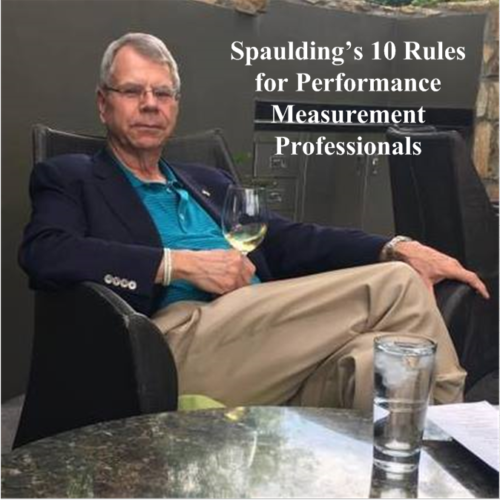
If you are linked to me on LinkedIn or follow me on Twitter, you’re familiar with this picture: it’s my rendition of Dos Equis’ “Most Interesting Man” promotion. It has been primarily a vehicle to convey a message in a humorous fashion. Well, today, it seemed fitting to use it to present to you 10 ideas (rules) I have to avoid being a “hidden figure” in performance measurement.
The source for the “hidden figure” notion
This week I’m in Sydney, Australia, speaking at the annual iPARM conference. And today I had a session titled “Hidden Figures” in Performance & Risk Measurement. I’ve given this talk a few times, including at sessions of the Performance Measurement Forum.
The talk was inspired by the movie, “Hidden Figures,” which tells the story of several black women who played instrumental roles in the success of America’s space program. The term “hidden figures” is a double entendre:
- The women, themselves, were hidden from view, because (a) they were women and (b) they were black.
- The mathematics necessary to successfully launch a spacecraft into orbit was hidden, and needed some imagination and strong analytical skills to uncover.
When I saw the movie I was inspired to use the idea of hidden figures in performance measurement.
It’s Marc Rubenfeld’s fault
As he has for the past four years, Eagle’s Marc Rubenfeld is this year’s chair for iPARM. And, as a good chair he had a question for me: Marc asked me to speak about the hidden figures that reside in performance measurement departments.
While I may not have answered his question exactly as intended, I took the opportunity to talk about ways that those who perhaps are hidden within their organization may leave the darkness and step into the light. And after further reflection, I thought that a blog post offering some of my thoughts might be of interest. And so, we have…
Spaulding’s 10 Rules for Performance Measurement Professionals
These rules are intended to help those in the field to grow beyond wherever they find themselves today.
- Get the CIPM: You probably know I’m a big fan of the CFA Institute’s Certificate in Investment Performance Measurement (CIPM®) program. It’s a great way for you to:
- Learn
- Easily and quickly demonstrate your level of expertise
- Show support for the performance measurement field.
- Be active on social media: I plan to do another post specifically on Twitter, but for now will simply encourage you to be active on social media. I’m on LinkedIn (linkedin.com/in/daviddspaulding), Twitter (@DSpauldingAtTSG), and Facebook. I rank LinkedIn as #1 in terms of places you absolutely need to have a presence. Twitter would be my second place to be, though admittedly it’s not nearly as far along from a professional standpoint as LinkedIn. Facebook is a network that should primarily be used to communicate with friends and family. Having a presence on LinkedIn doesn’t just mean that you’re there; you need to be active, too. And how can you be active? Well,
- Grow your number of connections
- “Like” and/or comment on posts
- Post meaningful comments yourself
- Join relevant industry groups.
- Write an article: Writing an article is a great way to demonstrate expertise. You can, of course, write the article for a publication such as The Journal of Performance Measurement®. You can also take advantage of LinkedIn’s own article capabilities.
- Give a talk: conference promoters are often looking for talented professionals to give talks, either solo or as part of a panel. If you’re like most people, you’ll be quite nervous the first time you do this, but do it enough times and you’ll grow more comfortable (and, most likely get better at it, too).
- Volunteer for committees: Local industry associations have committees that they’re usually looking for members for; and, of course, the CFA Institute and other similar bodies have committees they’re looking for help with. And so volunteer. Don’t be surprised if you have to try a few times to get accepted, but keep persevering. You’ll benefit the association, the industry, and yourself, too!
- Develop broad expertise and experience: If you want to leave the darkness and grow beyond being a hidden figure, you need to be better at what you’re doing.
- Attend conferences, lectures, classes, course: This is perhaps the best way to learn. And there are many other benefits from such face-to-face interactions. Also avail yourself of webinars, such as the ones TSG offers, in order to continue to learn and grow. The motivational speaker, Anthony (Tony) Robbins, uses the acronym CANI: Continuous And Never-ending Improvement: an idea we all should adopt.
- Read journal articles: This is a great way to keep up to date with the latest thinking. The Journal of Performance Measurement is just one of many resources available.
- Comment on GIPS® drafts: If your organization claims compliance with the Standards, you need to make your thoughts known when drafts for guidance statements and the Standards themselves are published. Even if your firm doesn’t comply, you may find that you want to express your thoughts.
- Grow beyond your job: You need to do more than what’s expected. You need to be able to not just report but to be able to explain.
You may need permission!
Of course, many, if not most, of these items may require approval from your superiors. And, in some cases permission may not be granted. But do as many as you can, so that you can stop being a “hidden figure” and shine!
As always, your thoughts are invited. Thanks!
